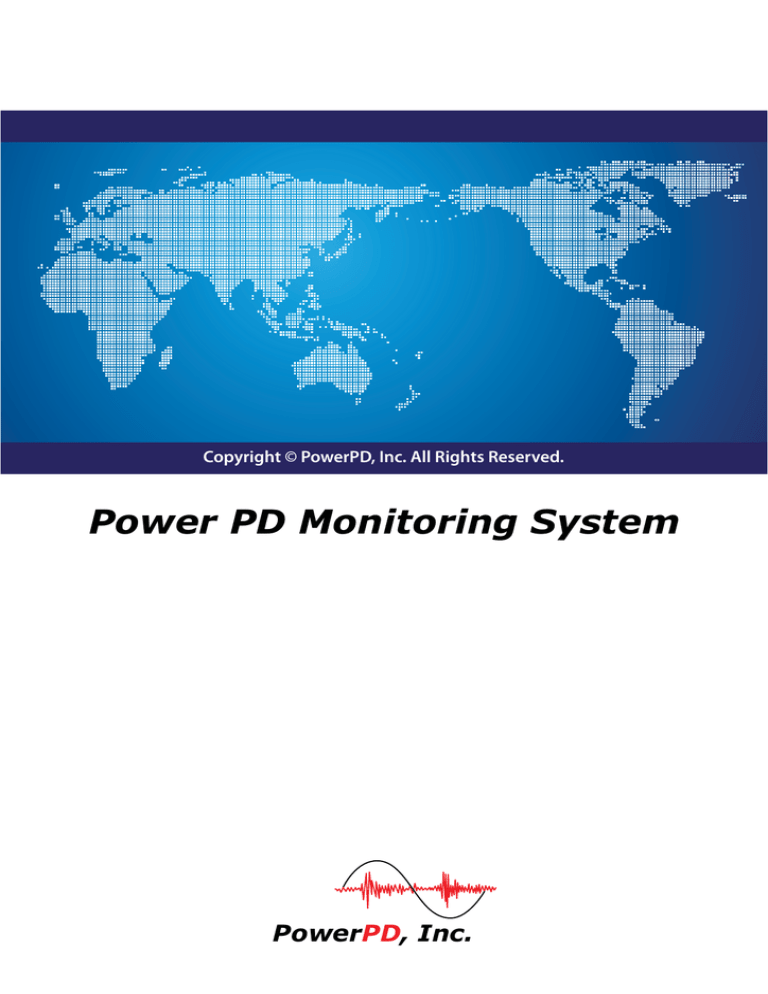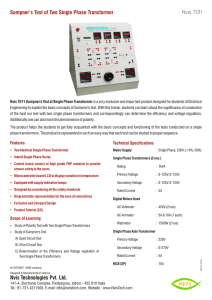
Copyright © PowerPD, Inc. All Rights Reserved.
Power PD Monitoring System
PowerPD, Inc.
Power PD Monitoring System
On-line monitoring of power transformers and associated accessories is becoming an essential feature of the electric utility systems of the future.
The justification for on-line monitoring is driven by the need to increase the
availability of power transformers, re-direction of time and/or operational-based
maintenance to condition-based maintenance, asset and life management; and
failure cause analysis.
Functions
Continuous Data Acquisition, Storage, Diagnostic
PD & Corona Detection Device Interface
Dissolved Gas Analysis (DGA) Device Interface
Tap Changer Interface
Bushing Monitor Interface
Over Load Capability
Insulation Moisture
Load & Fan, Pump, OLTC Motor Current Monitoring
Calculation Winding & Hot-Spot Temperature
Expert Cooling Control
Alarm/Event Logging
Life Management
Failure Cause Analysis
Modbus, DNP, IEC61850, IEC60870-101/104 Interface
“A Complet PDMS will help prevent eauipment failures.”
Some events lend themselves to an economic analysis:
Reduced inspection and maintenance costs
Reduced failure-related repair or replacement costs
Improved real-time transformer loading capability
Deferred upgrade capital costs due to load growth
Deferred replacement capital costs due equipment age or condition
There are also a number of other benefits that are tangible but cannot be quantified
easily:
Enhanced system reliability and availability with fewer unplanned outages
Improved planning for scheduled outages by using remote equipment condition assessment to avoid additional outages
Enhanced financial results with performance-based regulation
Optimized design and operating practices
Reduced commissioning costs
Increased equipment life
Enhanced personnel safety
Improved environmental safety
Retained knowledge of most skilled staff (expert system)
Improved system-wide access to key knowledge using Web tools
Copyright © PowerPD, Inc. All Rights Reserved.
Power PD Monitoring System
The HMI Solution is offered for transformer diagnosis System connected
SAS, SCADA, DCS, ECMS those are Suitable for various global standard
Control Center 1
Control Center 2
IEC 61970 EMS
IEC 61968 DMS
IEC61850, IEC60870-101/104, DNP3.0, Modbus
Ethernet
Utility
Communication
Network
IEC61850, IEC60870-101/104, DNP3.0, Modbus
Ethernet
Meter
Substation#1
Meter
Substation#2
Copyright © PowerPD, Inc. All Rights Reserved.
Power PD Monitoring System
2channels Redundant Fiber Optic Ethernet Port
Enough Communication channels for PD, DGA, Bushing, Fiber Optic Temperature Monitoring
Meter function for Rated current/voltage, Fan/Pump/LTC Motor current/voltage
Multi Source Interface through Analog Input, RTD Input
16channel Digital(Binary) Inputs for transformer status monitoring
Digital(Binary) Output for Fan/Pump Control and Alarm Indicates
A
B
SD Card
Data Logging
Standard 8GByte
(Option)up to 32Gbyte
D
Fiber Optic
C Digital Input
16Chanel
AC/DC Free Contact Voltage
(Over 80Vac/dc)
2Chnnel Ethernet
IEC61850/60870
DNP3.0
Modbus
C
Power
H
A B
80~264Vac, 50/60Hz
100~300Vdc
H
D
E Communications
Isolation RS-485 7Chennel for DGA,
Bushing, PD, F/O Temperature,
etc sensor interface
TCP/IP RJ45 Ethernet 1Chennel
USB 1Channel for Remote update with
CDMA, GSM Modem (Option)
E
F
G
Input
4 Digital Output(Dry Contact)
Cooling Control, Alarm
Isolation 4Chennel PT100Ω Input
Isolation 1Chennel OLTC tap position
resistance Input
G Analog Interface
F Voltage/Current
2Chnnel 110Vac voltage sensing
8Chnnel current sensing for load
& motor current
Item
Communication
Digital Output, RTD, LTCR
Isolation 9Chennel 4-20mA Input
Gas Sensor Interface
Fiber Optic Temperature Sensor Interface
Oil Temperature Interface
Pressure Interface
2 Channel 4-20mA Output
(Oil & Winding Temperature Output)
Point
Remark
F/O Ethernet
2
RS485
7
AC Voltage
2
R, S, T or Motor
AC Current
8
R, S, T, N or Motor
DI
16
Dry Contact
AI 4 – 20mA Input
9
RTD(PT100 ohm) / LTC Tap Position Resistance
4/1
DO Relay
4
AO 4 - 20mA
2
Output
Copyright © PowerPD, Inc. All Rights Reserved.
Power PD Monitoring System
Expert provides powerful features of PDMS.
<DGA Trend Line Analysis>
By the prediction of DGA Trend, it can overcome weakness that
existing dissolved gas analysis had.
Many global standards make the alarm if the values exceed limits
specified value, but this is not enough to prevent transformer problems in advance.
By trend line, user can know current and future status of transformer intuitionally.
<Duval triangle method>
For DGA fault interpretations in power transformers is very simple
(with three gases only) and consuming less time.
This method has satisfied the fault diagnosis (both manual and
software implementation) >95% accurate than any other method
of diagnostics.
Traces of one of the three gases can provide the quick fault diagnosis to a little experienced worker on the power transformers.
This method always provides a diagnosis with a very low percentage of wrong diagnosis.
<Per Unit Life Time & Ageing Factor Calculation>
Using the IEEE Guide for Loading of Oil-Immersed Power Transformers C57.91-1995, one can thermally rate transformers beyond their
nameplate conditions to a level that is safe for operation. Using the
guide, engineers can establish continuous, emergency and short
term emergency transformer ratings. Operators can use these
ratings until the contingency conditions are mitigated. However,
once the transformer has surpassed the short term emergency
ratings, the transformer might reach critical temperatures and
could possibly sustain damage. Protection engineers can avoid
further transformer damage by using the thermal protection principles of the IEEE standard. The PDMS support the fundamental
thermal principles of power transformers, philosophies of operations and the implementations of thermal protection.
Copyright © PowerPD, Inc. All Rights Reserved.
Power PD Monitoring System
Performance Test
Power : AC 110V/0.3A, 220V/0.16A,
DC 125V/0.22A(Nominal)
< EUT Setting >
- Rated Aux power supplied
- CT : 5A supplied
1MHz burst immunity test
< Test Specification >
- Voltage rise time : 75ns
- Oscillation frequency : 1MHz
- Repetition rate : 400Hz
- Output impedance : 200Ω
- Relation to power supply : asynchronous
- Polarity : positive, negative
- Burst duration : not less than 2s each
- Test voltage : common 2.5kV, differential 1.0kV
Electrostatic discharge test
< Test Specification >
- Contact discharge : 8.0kV
- Air discharge : 15.0kV
- Number of discharge : 10 times each
- Discharge interval : 1s
Radiated electromagnetic field disturbance test
< Test Specification >
- Frequency : 80MHz ~ 1GHz, 1.4GHz ~ 2.7GHz
- Modulation : 80% AM by 1kHz sine wave
- Dwell time : 1s
- Step size : 1% of fundamental
- Field polarization : vertical and horizontal
- Placement : 0.8m above GPR
- Field strength 10V/m
Electrical fast transient burst immunity test
< Test Specification >
- Voltage rise time : 5ns
- Duration time to 50% peak voltage : 50ns
- Burst duration : 15ms
- Burst period : 300ms
- Relation to power supply : asynchronous
- Polarity : positive and negative
- Test duration : 60s each
- Test voltage Repetition rate : 4.0kV, 5.0kHz
Surge immunity test
< Test Specification >
- Voltage waveform : 1.2 X 50 μs
- Current waveform : 8.0 X 50 μs
- Output impedance : 2 Ω, 12 Ω(Aux. Power)
42 Ω(CT, DO, etc)
- Relation to power supply : asynchronous
- Polarity : positive, negative
- Repeat : 5times each
- Repetition rate : 60s
- Test voltage : common 2.0kV, Differential 1.0kV
Conducted disturbance test
< Test Specification >
- Frequency : 150 kHz ~ 80MHz
- Dwell time : 1s
- Step size : 1% of fundamental
- Test voltage level : 10V
Conducted emission & Radiated emission test
< Test condition >
- CISPR 22 Class A
Vibration, shock and seismic test
< Test condition >
- Vibration response :
Frequency range : 10 Hz ~ 150Hz
Crossover frequency : 60Hz
Test Parameter
Below 60Hz : Peak displacement 0.035 mm
Above 60Hz : Peak acceleration 0.5G(4.9 m/s2)
Sweep cycle : 1(about 8 min)
Direction : three different axes of the specimen
in turn
- Vibration endurance
Frequency range : 10Hz ~ 150Hz
Peak acceleration : 1G(9.8 m/s2)
Sweep cycle : 20(about 160 min)
- Shock response
Peak acceleration : 5G(49 m/s2)
Pulse duration : 11ms
Direction : three difference axes of the specimen in turn
Pulse number(each direction) : 3
- Shock endurance
Peak acceleration : 15G(147 m/s2)
Pulse duration : 11ms
Direction : three difference axes of the specimen in turn
Pulse number(each direction) : 3
- Bump
Peak acceleration : 10G(98 m/s2)
Pulse duration : 16ms
Direction : three difference axes of the specimen in turn
Pulse number(each direction) : 1,000
- Seismic test
Frequency range : 1Hz ~ 35Hz
Crossover frequency : 8.5Hz
Horizontal parameter :
Below 8.5Hz : Peak displacement 3.5mm
Above 8.5Hz : Peak acceleration 1G(9.8 m/s2)
Vertical parameter :
Below 8.5Hz : Peak displacement 1.5mm
Above 8.5Hz : Peak acceleration 0.5G(4.9 m/s2)
Sweep cycle : 1(about 10 min)
Direction : three difference axes of the specimen in turn
Copyright © PowerPD, Inc. All Rights Reserved.
Copyright © PowerPD, Inc. All Rights Reserved.
Center Park Plaza, 6131 Orangethorpe Ave. Suite 260, Buena Park, CA 90620, U.S.A
Tel : 1.714.522.7676 / Fax : 1.714.522.7677
E-mail : william.lee@powerpd.net



